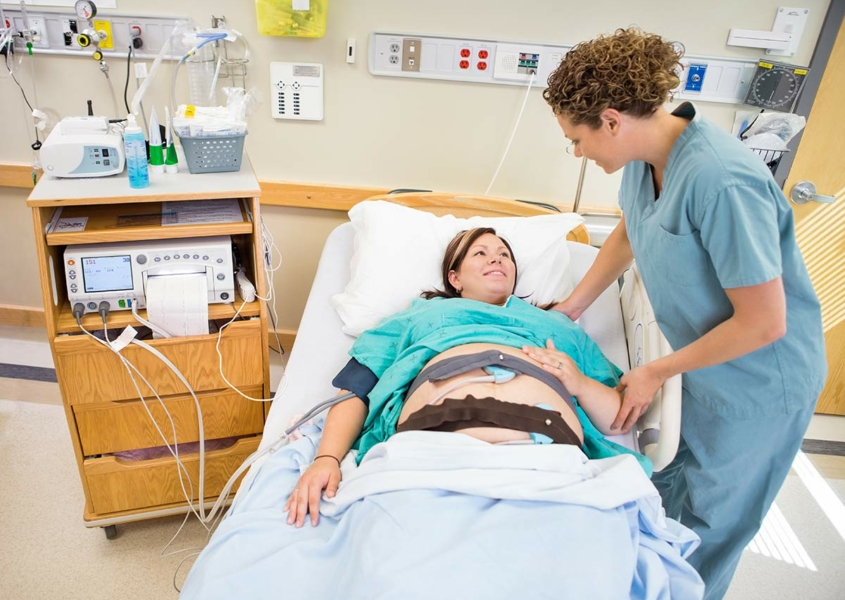Epidurals for Labor: Risks, Benefits and Other FAQs
It’s no secret that giving birth is painful! But every woman finds a way to manage the pain of childbirth — whether that’s through breathing exercises, position changes, or an epidural.
During your third trimester, your OBGYN will ask you about your preference for pain management during labor. Whatever your decision, you can change your mind even during labor (up until a certain point). Our goal is to support you so that you can have a positive birthing experience, whatever that looks like for you.
About 70% of women in our practice choose to receive an epidural during labor. And all of them have had very similar questions, fears and concerns about the process.
What is an epidural?
An epidural is a common type of anesthetic used in labor for pain relief. Epidurals are the best option available for relieving labor pain. An epidural can be given at any time during the labor process.
While you are sitting up an anesthesiologist will first numb your skin and then insert a needle and a tiny tube (called a catheter) into the lower part of your back. The needle is removed and the catheter is left in place so that medication can be delivered through the tube. The medication typically runs continuously until delivery, with more medication given through the tube as needed.
The process takes about 15 minutes to complete. As long as you’re able to get into the right position and stay still for the time it takes to place the catheter, you can receive the epidural at any point during labor. That means that you can still receive an epidural even if you initially thought you didn’t want one!
Is the epidural needle painful?
Before the epidural is placed, you’ll be given a numbing injection. The first injection will feel like a short bee sting. This lasts only for a moment. Once that area is numb from the injection, the anesthesiologist will place the catheter to deliver the pain relieving medication. It takes about 20 minutes for contraction pain to subside.
An epidural creates a feeling of numbness from your belly to your toes. You may still feel pressure during labor, but the pain will be drastically reduced. If you are still uncomfortable even after having the epidural placed, the anesthesiologist may give you additional medication through the catheter or place the catheter in a slightly different position.
Because you will feel numb, it will be hard to move your legs. You won’t be able to walk around with an epidural in place. You may not feel as great of an urge to push, but you will still be able to push. Your team will help you know when and how to push through your contractions.
You also won’t feel the need to urinate, so we will place a foley catheter in your bladder.
Will an epidural harm my baby?
Medication from an epidural does NOT harm your baby. Because the anesthesia from the epidural doesn’t enter your bloodstream, it will not transfer to your baby through the placenta.
How long does the epidural last?
The epidural is intended to last for the duration of your labor and will be removed after you deliver your baby. It will take a couple of hours for the numbness to completely go away. You will be able to walk around after the epidural wears off.
To manage pain after delivery, you’ll be given ibuprofen. Ice packs can also be applied to help with discomfort after labor.
What are the side effects from an epidural?
Epidurals are very safe. Serious complications are rare. The most common side effect we see is a decrease in blood pressure. To prevent this, you will be given extra IV fluid before having an epidural placed. If needed, the anesthesiologist may also give you medication to bring your blood pressure up.
Who shouldn’t get an epidural?
Occasionally there are circumstances where women can’t get an epidural. Occasionally we see this in women who have a low platelet count. Additionally, women who are taking blood thinners (such as heparin) to prevent a blood clot during pregnancy should not receive an epidural within 12 hours of taking that medication.
Will an epidural slow down delivery or cause me to need a C-section?
Some women are actually able to deliver more quickly after receiving an epidural because they feel more relaxed. They can push through the stronger contractions because they are in less pain. Other women may be in labor a little longer because they do not feel the urge to push to the same extent.
Your labor and delivery team will monitor you and your baby to be sure that you are progressing through labor at a safe rate.
There is no evidence that receiving an epidural makes you more likely to require a C-section. In fact, if you do need a C-section, having an epidural in place can help you be prepared for the C-section more quickly.
Other Ways to Manage Pain During Childbirth
An epidural is not the only way to manage pain during childbirth. You have several options available to you. You are also able to make changes to your birth plan while you are in labor.
Non-medicated pain control options
There are several non-medicated (or non-pharmacologic) pain control options. Read about other methods of pain relief during childbirth.
Intravenous (IV) and Intramuscular pain relief:
Pain relieving medication (opioids) can be given to help take the edge off of labor pain to make it more tolerable. This medication is either given to you through an IV or as an injection.
Opioids given through an IV catheter do enter your bloodstream, therefore they do transfer to your baby. Side effects include grogginess or sleepiness for both you and your baby.
Conclusion
We don’t judge your reasons for or against receiving an epidural. Some of our patients choose not to receive any pain medications during labor while others request an epidural as soon as possible. (You may be surprised by how many women change their minds during labor!) There isn’t a right or wrong way of giving birth, and you aren’t more or less of a mom or a woman based on your pain management decision.
Whether you want a less painful labor or a medication-free labor, we are here to support you. Our goal is that you and your baby are safe and healthy!











